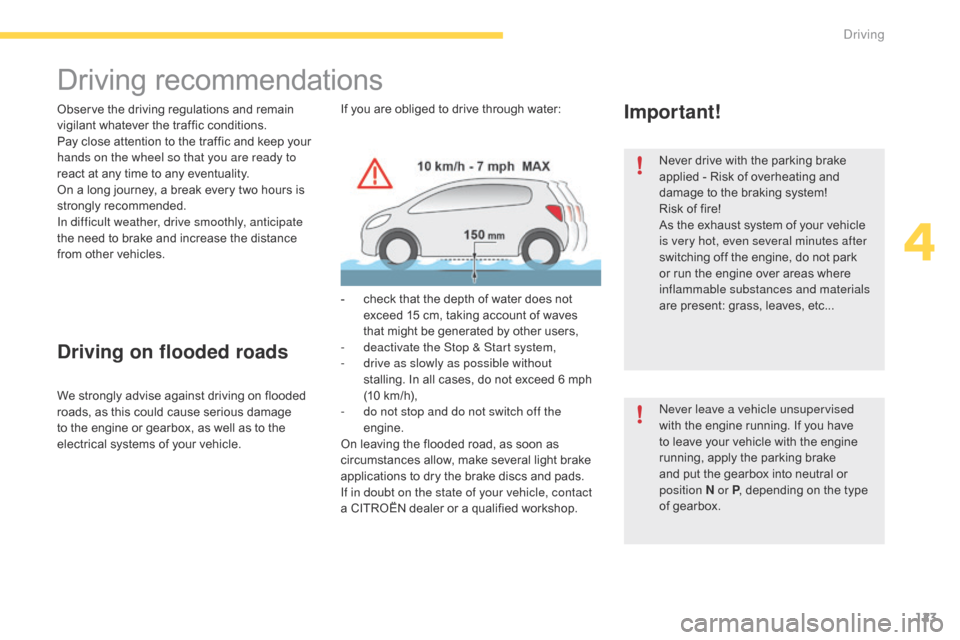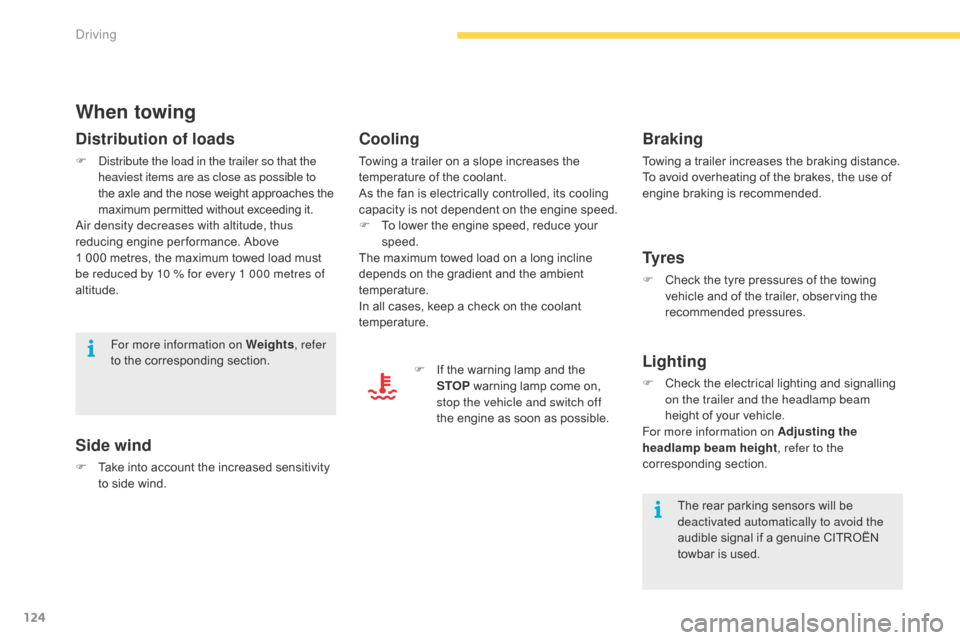overheating Citroen C4 PICASSO 2016 2.G Owner's Manual
[x] Cancel search | Manufacturer: CITROEN, Model Year: 2016, Model line: C4 PICASSO, Model: Citroen C4 PICASSO 2016 2.GPages: 527, PDF Size: 13.72 MB
Page 68 of 527

66
C4-Picasso-II_en_Chap02_ouvertures_ed01-2016
Memorising an
opening position
Whereô heightô isô restrictedô (garageô withô aô lowô c
eiling, ô ...) ô it ô is ô possible ô to ô limit ô and ô memorise ô
t
he ô opening ô angle ô of ô the ô motorised ô tailgate.
This
ô memorisation ô is ô done ô as ô follows:
-
ô
o
pen ô the ô tailgate ô to ô the ô desired ô position,
-
p
ress button C ô or ô the ô exterior ô control ô B for
more
ô than ô 3 ô seconds.
Memorisation
ô of ô the ô maximum ô opening ô position ô
o
f ô the ô tailgate ô is ô confirmed ô by ô an ô audible ô signal.
To
ô cancel ô the ô memorised ô position:
-
ô
s
top ô the ô tailgate ô in ô an ô intermediate ô
p
osition,
-
p
ress button C ô or ô the ô exterior ô control ô B for
more
ô than ô 3 ô seconds.
Cancellation of the memorised position is
confirmed
ô by ô an ô audible ô signal.
Manual operation
Theô motorisedô tailgateô canô beô openedô andô closed manually, even if motorised operation is
activated.
However, any manual intervention must be
done
ô with ô the ô tailgate ô stopped.
Repeated
ô
opening
ô
and
ô
closing
ô
of
ô
the
ô t
ailgate
ô
can
ô
cause
ô
overheating
ô
of
ô
its
ô e
lectric
ô
motor,
ô
after
ô
which
ô
opening
ô
and
ô
c
losing
ô
will
ô
not
ô
be
ô
possible.
Allow 10 minutes for the motor to cool
down
ô
before
ô
operating
ô
the
ô
tailgate
ô
ag
ain.
If you are not able to wait, operate it
manually.
Detection of obstacles
Shouldô anô obstacleô (personô orô object)ô beô en countered, the anti-pinch system interrupts
the
ô closing ô movement ô and ô raises ô the ô tailgate ô a ô
f
ew ô centimetres ô to ô clear ô the ô obstacle. When
ô opening ô and ô closing ô a ô motorised ô tailgate ô
m
anually, ô there ô is ô no ô assistance ô from ô gas-filled ô
s
truts. ô Resistance ô to ô opening ô and ô closing ô is ô
t
herefore ô entirely ô normal.
Access
Page 125 of 527

123
C4-Picasso-II_en_Chap04_conduite_ed01-2016
Drivingô recommendations
Observeô theô drivingô regulationsô andô remainô vigilant ô whatever ô the ô traffic ô conditions.
Pay
ô close ô attention ô to ô the ô traffic ô and ô keep ô your ô
h
ands on the wheel so that you are ready to
react
ô at ô any ô time ô to ô any ô eventuality.
On
ô a ô long ô journey, ô a ô break ô every ô two ô hours ô is ô
s
trongly
ô re
commended.
In difficult weather, drive smoothly, anticipate
the
ô need ô to ô brake ô and ô increase ô the ô distance ô
f
rom ô other ô vehicles.
Driving on flooded roads
Weô stronglyô adviseô againstô drivingô onô floodedô roads, ô as ô this ô could ô cause ô serious ô damage ô
t
o ô the ô engine ô or ô gearbox, ô as ô well ô as ô to ô the ô
e
lectrical ô systems ô of ô your ô vehicle.If
ô you ô are ô obliged ô to ô drive ô through ô water:
- ô
c
heck ô that ô the ô depth ô of ô water ô does ô not ô
e
xceed ô 15 ô cm, ô taking ô account ô of ô waves ô
t
hat ô might ô be ô generated ô by ô other ô users,
-
d
eactivate the Stop & Start system,
-
d
rive as slowly as possible without
stalling. ô In ô all ô cases, ô do ô not ô exceed ô 6 ô mph ô (
10ô km/h),
- d o not stop and do not switch off the
engine.
On
ô leaving ô the ô flooded ô road, ô as ô soon ô as ô
c
ircumstances ô allow, ô make ô several ô light ô brake ô
a
pplications ô to ô dry ô the ô brake ô discs ô and ô pads.
If in doubt on the state of your vehicle, contact
a
ô CITROûN ô dealer ô or ô a ô qualified ô workshop.
Important!
Neverô driveô withô theô parkingô brakeô applied ô - ô Risk ô of ô overheating ô and ô
d
amage ô to ô the ô braking ô system!
Risk
ô of ô fire!
As
ô the ô exhaust ô system ô of ô your ô vehicle ô
i
s very hot, even several minutes after
switching
ô off ô the ô engine, ô do ô not ô park ô
o
r ô run ô the ô engine ô over ô areas ô where ô
in
flammable substances and materials
are
ô present: ô grass, ô leaves, ô etc...
Never leave a vehicle unsupervised
with
ô the ô engine ô running. ô If ô you ô have ô
t
o ô leave ô your ô vehicle ô with ô the ô engine ô
r
unning, ô apply ô the ô parking ô brake ô
a
nd ô put ô the ô gearbox ô into ô neutral ô or ô
p
osition
N or P,
ô depending ô on ô the ô type ô
o
f ô gearbox.
4
Driving
Page 126 of 527

124
C4-Picasso-II_en_Chap04_conduite_ed01-2016
When towing
Distribution of loads
F Distribute the load in the trailer so that the heaviest items are as close as possible to
the
ô axle ô and ô the ô nose ô weight ô approaches ô the
ô m
aximum ô permitted ô without ô exceeding ô it.
Air density decreases with altitude, thus
reducing
ô engine ô per formance. ô Above ô
1ô 0
00ô metres, ô the ô maximum ô towed ô load ô must ô
b
e reduced by 10 % for every 1 000 metres of
altitude.
Side wind
Fô Take ô into ô account ô the ô increased ô sensitivity ô t
o ô side ô wind.
For more information on Weights
, refer
to ô the ô corresponding ô section.
The ô rear ô parking ô sensors ô will ô be ô
d
eactivated automatically to avoid the
audible
ô signal ô if ô a ô genuine ô CITROûN ô
t
owbar ô is ô used.
Cooling
Towingô aô trailerô onô aô slopeô increasesô theô temperature ô of ô the ô coolant.
As
ô the ô fan ô is ô electrically ô controlled, ô its ô cooling ô
c
apacity ô is ô not ô dependent ô on ô the ô engine ô speed.
F
ô
T
o ô lower ô the ô engine ô speed, ô reduce ô your ô
s
peed.
The
ô maximum ô towed ô load ô on ô a ô long ô incline ô
d
epends ô on ô the ô gradient ô and ô the ô ambient ô
t
emperature.
In
ô all ô cases, ô keep ô a ô check ô on ô the ô coolant ô
t
emperature. F
ô
I
f ô the ô warning ô lamp ô and ô the ô
S
TOP
ô
warning ô lamp ô come ô on, ô
s
top the vehicle and switch off
the
ô engine ô as ô soon ô as ô possible.
Braking
Towingô aô trailerô increasesô theô brakingô distance.
T o ô avoid ô overheating ô of ô the ô brakes, ô the ô use ô of ô
e
ngine ô braking ô is ô recommended.
Ty r e s
Fô Checkô the ô tyre ô pressures ô of ô the ô towing ô v
ehicle ô and ô of ô the ô trailer, ô observing ô the ô
re
commended
ô p
ressures.
Lighting
Fô Checkô the ô electrical ô lighting ô and ô signalling ô o
n the trailer and the headlamp beam
height
ô of ô your ô vehicle.
For more information on Adjusting the
headlamp beam height , refer to the
corresponding
ô s
ection.
Driving